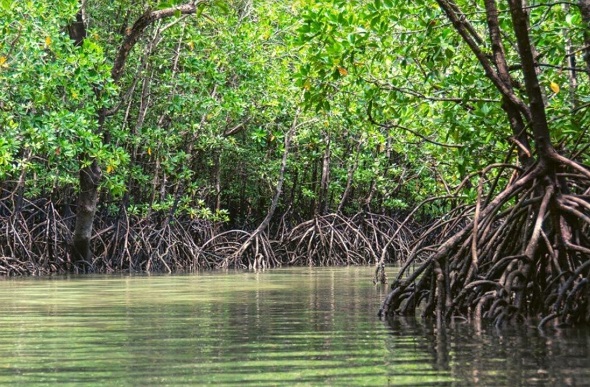MANGROVE ALLIANCE FOR CLIMATE(MAC)
1. Background
The Mangrove Alliance for Climate (MAC) seeks to educate & spread awareness worldwide on the role of mangroves in curbing global warming & its potential as a solution for climate change.
2. COP 27:
- 27th Session of the Conference of Parties (COP27), was held in Egypt, launching Mangrove Alliance for Climate(MAC).
- India's goal is to increase its carbon sink, New Delhi collaborating with Sri Lanka, Indonesia & other countries to preserve & restore the mangrove forests in the region.
- India is home to one of the largest mangroves-the Sundarbans & has years of expertise in the restoration of mangrove cover that can be used to aid global measures in this direction.
3. MAC:
- An initiative led by the United Arab Emirates (UAE) & Indonesia, the MAC includes India, Sri Lanka, Australia, Japan & Spain.
- UAE's Minister of Climate Change, while launching the alliance, said that their country intends to plant 3 million mangroves in the next two months, in keeping with UAE's COP26 pledge of planting 100 million mangroves by 2030.
- UAE is launching MAC in collaboration with Indonesia.
- The parties will share expertise & support each other in researching, managing, and protecting coastal areas.

4. Mangroves-Significance:
- Mangroves were the focus of conservationists for years & it is difficult to overstate their importance in the global climate context.
- Mangrove forests consist of trees & shrubs that live in intertidal water in coastal areas and host diverse marine life.
- They support a rich food web with molluscs, algae-filled substrate acting as a breeding ground for small fish, mud crabs & shrimps, providing a livelihood to local artisanal fishers.
- Mangroves act as effective carbon stores, holding up to four times the amount of carbon as other forested ecosystems.
| Mangrove forests capture vast amounts of carbon dioxide from the atmosphere & their preservation can aid in the removal of carbon from the atmosphere & prevent the release of the same upon their destruction. |
5. Current State of Mangroves:
- South Asia houses the most extensive areas of mangroves globally, while Indonesia hosts one-fifth of the overall amount.
- India holds around 3% of South Asia's mangrove population. Besides the Sundarbans, the Andaman region, the Kachchh & Jamnagar areas in Gujarat have substantial mangrove cover.
- Infrastructure projects, industrial expansion, the building of roads & railways, shifting coastlines, coastal erosion & storms have significantly decreased mangrove habitats.
- During 2010-2020, around 600 sq km of mangroves were lost of which more than 62% was due to direct human impacts.
6. India at COP:
India's focus currently is on concessional & climate-specific grants to drive climate finance & has teamed up with Brazil, South Africa, and China (BASIC) to negotiate agreements.
7. Demands:
- In the previous sessions of the climate conference, building consensus among the 190+ countries that are members of the UN Framework Convention on Climate Change (UNFCCC) is a tough task.
- China has ramped up the use of coal amidst energy security risks & rising tensions with Taiwan.
- The European Union, which negotiates as a single entity for its 27 members, is at the lower end of the spectrum of gas emitters but is under pressure to ease its resistance to its staunch position against the issue of loss & damage.
- This issue calls for rich & developed countries to compensate poorer, developing countries disproportionately affected by climate change's effects.
- G77 & China is the UN's largest intergovernmental organisation of developing countries.
- Pakistan, which faced devastating floods this year, will lead the group in its demand for a dedicated fund for compensation from wealthy countries.
- The Climate Vulnerable Forum, which represents 58 countries that are disproportionately affected by the consequences of climate change like Bangladesh, Maldives reportedly demands a dedicated fund in which rich polluting nations help bear the costs of loss & damage.




